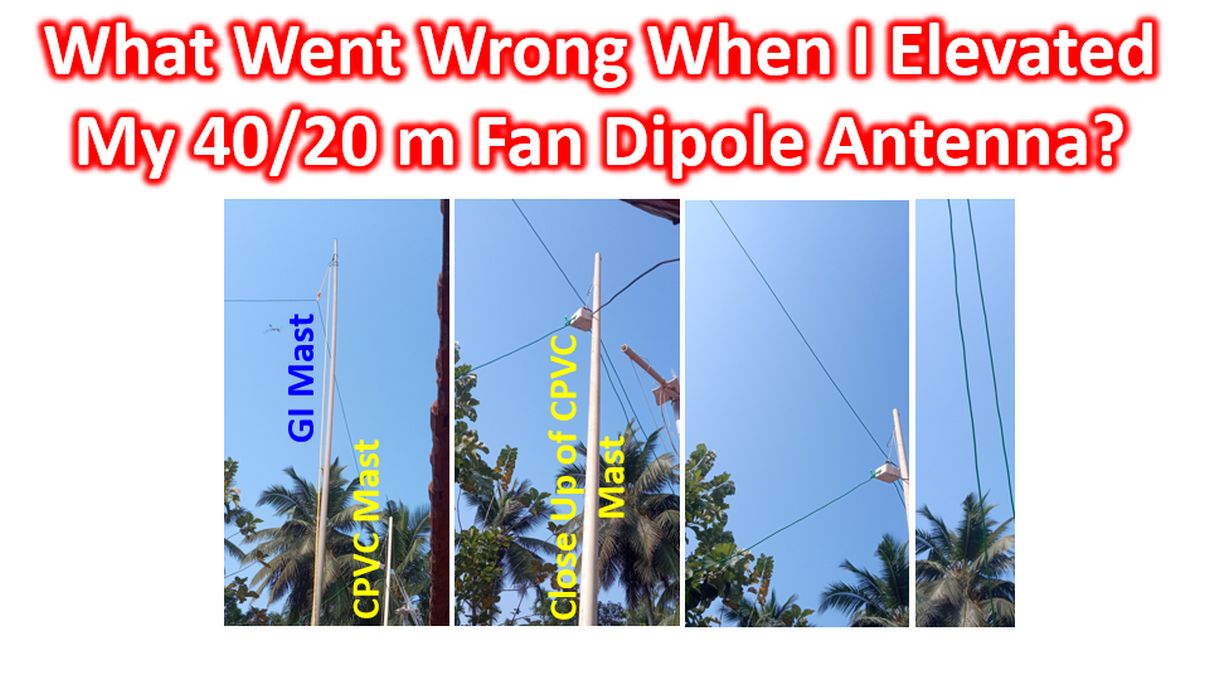What Went Wrong When I Elevated My 40/20 m Fan Dipole Antenna?
I have been experimenting with my 40/20 m Fan Dipole Antenna for the past few days. My average reports on 40 m was 5,7 though occasionally I used to get 5,9 report. On 20 m, I could get a couple of DX and few VU contacts, with reports ranging from 5,3 to 5,5. Today being the first day of ARSI Field Day and Hill Topping Contest, I thought of elevating the antenna a bit to join the fun, being a proud member of ARSI, though I will be operating from home QTH only! The antenna had only one length of 6 m long GI pipe as an asymmetric mast, about 2 m from the feedpoint. So the feedpoint was only at an arm’s length from the first floor fence. I decided to add a second mast using the spare 3 m CPVC hot water pipe I had in store.

Setup a short piece of insulated copper wire as a ring on top of the CPVC pipe as a make shift pulley to elevate the feedpoint of the antenna using a thin nylon rope. Fixed the CPVC pipe to the first floor terrace fence so that the total height over the terrace would be about 4 m and height from ground would be about 7 m. I had released the ties of the antenna at the lower ends to facilitate the work. Then I pulled the feedpoint region up so that it was about 1 foot below the tip of the mast. Tied both 40 and 20 m components of the fan dipole back to the compound fence as before, though with a little change in the orientation between the two, to prevent pressing on a TV cable.
To my dismay, when I checked the fan dipole antenna again, the SWR had gone beyond the tunable range of my automatic antenna tuner on 20 m. Instead of bringing down the antenna again for further checks, I thought of testing what change it had made on 40 m as I was a bit tired of the early morning work going up and down the stairs several times. A pleasant surprise awaited me on 40 m. I could tune the antenna to multiple frequencies across the 40 m Amateur Radio band with the built-in automatic antenna tuner. I could check in to multiple 40 m morning nets and had comfortable contacts with other stations, with reports mostly in the range of 5,9 from Goa, Andhra Pradhesh, Karnataka, Tamil Nadu and Kerala. Happiest of the contacts was with an ARSI Field Day Station with special callsign AT3POG operated by VU3TBU!
Now I have to check what went wrong with the 20 m component of the dual band fan dipole antenna. Went upstairs and got a few pictures of the feedpoint, masts and initial part of the fan dipole, to ‘analyze’ before going further. Looking at the way in which the dipole elements diverge, there is a good separation between the two towards the East, while they are close to each other towards the West. The asymmetric pattern is out of necessity as I do not have space at home for a good symmetric fan dipole, and for that matter any good antenna. As the sun is very much high by this time, I am planning to do further modifications and testing of the fan dipole only on another day. May be I will try changing the angle between the elements on Western side first to make them a bit more divergent. If that does not work well, then I will have to bring down the antenna to see if joint between the 20 m and 40 m elements have become loose, as the feed point connects directly with 40 m elements only.
Update: Later I was told that if the elements are not parallel to each other, they have to be kept at right angles, to prevent interaction between the elements! If antenna is built for more than two bands, only option is to have elements in parallel, one below the other. While tuning, higher band has to be tuned first as radiofrequency on that band will not resonate on the lower band dipoles.